
|
Sale 16
Pre-Long Beach Coin and Currency Auction
| Lot |
Photo |
Description |
Realized |
Lot 1 |
|
R. S. Yeoman. A Guide Book of United States Coins. The first year and first printing of this most famous and highly collectible important numismatic reference work. After years of dominance in the market, Wayte Raymond's Standard Catalogue of United States Coins finally faced it's first challenge in mid 1946 when this book was published and distributed. Within a short time, Yeoman's little Guide Book soon dominated the market, and as coins enjoyed thousands of new collectors in the post war era, the little "red book" sold very well. In fact, the first year of 1947 sales were so strong that a second printing was ordered later in the year. While many collectors have several editions of this popular reference, very few have ever seen, much less owned, this first edition. Truly, this little books popularity shocked even Yeoman himself, as he described personally to this cataloger in 1986 at the Atlanta ANA. Demand continued to grow year by year, and the little Red Book, as it is now known, is a staple of virtually all United States coin collectors each year. This copy grades AU-50 in coin terminology, with excellent covers and strong gold embossing even on the spine, which is normally faded away on these early editions. An opportunity for the collector to purchase the "First" Guide Book edition.
Estimated Value $750 - 1,000.
From the Paul Authur Norris Collection.
View details
| Realized
$805 |
Lot 2 |
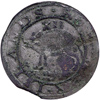 |
c.1616 Sommer Islands (Bermuda) Shilling, small sail. PCGS graded EF-40. One of the classic rarities of the colonial series, only a few were known before the advent of metal detectors located several more in the Bermuda Islands. These were struck at the authorization of the Governor Daniel Tucker who was in office for just two years, 1616 to 1618. It is not known who made them, but they were struck using the ancient hammer method. The planchets were thin and seldom round, and silvered lightly to simulate value. Curiously the silvering caused the coins to rapidly corrode, and hence virtually none are known with smooth surfaces or much more than a trace of the original silvering. In particular we note this example is dark brown in color, with a fairly sharp strike. More or less round and well preserved, there are the usual areas of corrosion, but less so than on many others of this issue.
The Sommer Islands were named for Sir George Sommers (or Summers or Somers, all spellings recur) who ended up in the Bermuda Islands during a hurricane which forced his ship the Sea Adventure to seek shelter for repairs in 1609. Sommers left the Islands after the ships were repaired and returned to England, leaving a few sturdy men behind to claim the Islands for England. Those left behind were memorialized in Shakespeare's The Tempest with its allusion to the Islands. Meanwhile, Sommers returned to the Bermuda Islands the next year to bring provisions back to England, however Sommers died while in Bermuda. Thus the Islands were renamed from the Bermuda Islands (also Hogge Islands for the wild pigs on the Island which arrived via a shipwreck in 1532) to the Sommers Islands. In time, the name reverted back to the Bermuda Islands.
The coins depict the wild hog or boar, so many of which were found on the Island, and the reverse likely shows Sommer's flagship. Despite the numbers found in recent years, PCGS has graded a scant 3 so far, one in grades of VG-VF, and two as EF-40, with none higher! Most of those which have been located in the sands of Bermuda are in far worse shape than seen here, and many are corroded nearly beyond recognition. For many years only 2 were known (Crosby) and it wasn't until more recent times that a few dozen have been unearthed. If you demand a relatively attractive example of this rare coin, then bid accordingly as these rarities only turn up when major collections cross the block.
Estimated Value $35,000-UP.
From the Paul Arthur Norris Collection.
View details and enlarged photos
| Realized
$33,350 |
Lot 3 |
|
Withdrawn
| Unsold |
Lot 4 |
|
Withdrawn
| Unsold |
Lot 5 |
|
Withdrawn
| Unsold |
Lot 6 |
 |
1652 Oak Tree Shilling. Fine-12. A rare example for the specialist, this one has a larger but typically placed planchet crack on the lower left obverse. The "S" shape to the planchet resulted in uneven wear and we note the planchet is uniformly clipped and thus a bit smaller than others seen for this variety. The central oak tree is well struck, but the tops and bottoms are worn away by the uneven planchet. Toned a medium to dark antique silver color, and pleasing despite the planchet fissure and wear. An important offering for the die variety specialist, and an excellent study coin for an advanced collection.
Estimated Value $1,600 - 1,800.
View details and enlarged photos
| Realized
$1,898 |
Lot 7 |
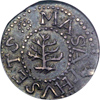 |
Pine Tree Threepence 1652. PCGS graded AU-55. Pleasing gunmetal gray in color, with excellent surfaces throughout. One minor straight edge above the rosette to the M, otherwise the planchet is very round and choice. As to the strike, we note sharp details on all but the D of ENGLAND on the reverse. Further, substantial die lines and engraving slips are plainly visible on this specimen, and there is no trace of the rim break at AS. PCGS has graded only 5 this high, with a single coin graded higher of this issue. A splendid opportunity for the specialist to acquire a very scarce coin. PCGS has graded 5 this high, but importantly, only 3 are graded higher.
Estimated Value $6,000 - 8,000.
From the Paul Arthur Norris Collection.
View details and enlarged photos
| Realized
$4,830 |
Lot 8 |
 |
1652 Pine Tree Threepence. VF-20. This is the rarest of the Pine Tree threepences. Light silvery gray in color with traces of darker hues near the lettering and devices. Unevenly struck, as expected from the rocker dies. The reverse centering is a off towards 5 o'clock, but the erroneous backwards D is quite plain near the edge. There is a series of short cuts in the lower reverse and these seem to be the only post minting problem on this very rare and desirable specimen.
Estimated Value $1,600 - 1,800.
This variety was missing from the Stearns and Picker sales.
View details and enlarged photos
| Realized
$2,300 |
Lot 9 |
|
Withdrawn
| Unsold |
Lot 10 |
 |
1652 Pine Tree Sixpence. PCGS graded AU-50. The obverse is struck off center as always seen, as the rocker dies were not properly aligned while the reverse is always well centered. A classic "type" example, this being a more common variety, which shows the design elements well and is often found in higher grades too. The tree is quite sharp, and we note the two pellets which flank the trunk. The die line or break between the 16 in the date is well developed, with a broad lump left and above the 6. Darkly toned in the fields, the surrounding devices a lighter silver color. Relatively clean surfaces, and struck on a wavy planchet, as were all, as this is part of the rocker die coining process.
Estimated Value $6,000 - 7,000.
View details and enlarged photos
| Unsold |
Lot 11 |
 |
1652 Pine Tree Sixpence. VF-20. With the familiar "S" bend in the planchet from the rocker press, and unevenly worn on the obverse. When coinage began of this die pairing, the dies were not properly aligned, and most were struck with the obverse well off center, eventually the coiners adjusted the dies so they were aligned properly (Noe-33a). This particular specimen is very sharply struck on the reverse, and boasts a light silvery gray color enhanced by darker flecks near the devices. Struck on a nice large and round planchet, and as such, would make a perfect type or variety coin for the collector.
Estimated Value $1,700 - 1,900.
View details and enlarged photos
| Realized
$2,300 |
Lot 12 |
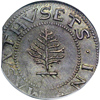 |
Pine Tree Shilling, large planchet 1652. PCGS graded AU-55. Pale iridescent silver and blue on both sides, with ample luster in the fields near the devices. A later die state than most, with a vertical crack noted on the tree trunk, and the reverse with a virtually bisecting break at the top of the date. Other cracks are present as well, one at the top of the denomination, a lump is present on the upper left of D(OM) and a larger lump on (A)N. Nicely round save for a straight edge clip on the left obverse, and sharply impressed for the issue with just a trace of weakness on left side of the M, with all other design elements bold and complete. A classic example of this ever popular type coin, and one which is rarely found in such superlative condition.
Estimated Value $7,000 - 9,000.
From the Paul Arthur Norris Collection.
View details and enlarged photos
| Realized
$6,613 |
Lot 13 |
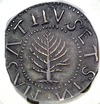 |
1652 Pine Tree Shilling. Large planchet. PCGS graded AU-53. This is the famous backwards "N" in ENGLAND on the reverse. The tree is quite sharp, and the planchet is slightly oblong, but not too far out of round, with a small straight edge on the left side. As always, the rocker dies produced a slightly wavy planchet, but the lettering and all devices clear. Later die state with the lower reverse starting to fail, and the break in the field left of the date well developed. Always in demand for the engraving error, and a very popular type coin as well. Steel gray with blue iridescence, the fields lighter gray with darker areas hugging the lettering and devices. A most pleasing example for the numismatist.
Estimated Value $7,000 - 8,000.
View details and enlarged photos
| Unsold |
Lot 14 |
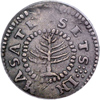 |
1652 Pine Tree Shilling. Small planchet. PCGS graded EF-40. A scarcer die pairing than many, and one that should be worth a premium with the popularity of these colonial coins increasing dramatically. Unevenly struck at the top and bottom of the obverse, characteristic of this variety. The tree and most of the peripheral lettering is sharp. Toned a medium to dark gray in the fields, and slightly lighter on the devices, accenting the design elements. Colonial coins are finally coming into their own in the past few years, with increasing popularity and a fixed supply, prices have been increasing at long last.
Estimated Value $4,500 - 5,000.
View details and enlarged photos
| Unsold |
Lot 15 |
 |
1652 Pine Tree Shilling. Small planchet. VF-20. This is the straight branch variety. The edges of this one have been uniformly clipped making the planchet quite round, but the tops of most of the lettering is missing. Fully struck on the tree, although the top is slightly weak. We note minor encrustation near the centers on both sides. A bold example of this scarce variety.
Estimated Value $1,900 - 2,200.
View details and enlarged photos
| Unsold |
Lot 16 |
|
Withdrawn
| Unsold |
Lot 17 |
|
Withdrawn
| Unsold |
Lot 18 |
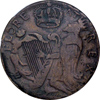 |
St. Patrick Copper "Farthing". PCGS graded EF-40. This is currently the finest graded by PCGS of this important colonial issue, and truly of exceptional quality. The color is a perfect chocolate brown and the planchet choice and well preserved. On the crown traces of the original brass splash can still be seen, as well as a few tiny corrosion spots in that area. Sharply struck for the issue, and well centered too. We note that PCGS has graded 13 examples of this coin in grades from VG to VF, and this single example as EF-40, with none higher.
Originally intended for the Irish, the coins were rejected there for political reasons, and soon made their way to the American colonies, where small change was in great need. Most circulated to much lower grades than seen here.
Estimated Value $3,000 - 3,500.
From the Paul Arthur Norris Collection.
View details and enlarged photos
| Realized
$2,415 |
Lot 19 |
 |
St. Patrick Silver "Farthing". PCGS graded AU-55. A rare silver example of this important Colonial issue, the surfaces are pleasing and smooth save for some minute granularity at the centers, probably as struck. No handling marks worthy of note, and this is likely one of the finest examples extant in silver. One minor toning streak through the harp to the King, otherwise a dark silvery gray color. Fairly well struck, with some details on the obverse face, less so on the reverse. These coins are notorious for their weak strikes, and the Garrett collection contained the only finer examples. PCGS has graded only 2 this high, with none graded higher in silver, of a total of just 8 examples graded. A foremost rarity in top grade, and worthy of the finest collection.
This is a regular die issue but was struck in silver, known as an "off metal striking". These St. Patrick or Newbie's coppers were struck in the Tower Mint in London around 1641-42. The Catholic troops of Charles I had to be paid, and once the Long Parliament seized the Tower Mint, these coins were used to pay the loyalist troops fighting Cromwell's Protestant forces in the Ulster Rebellion. The tide turned against the King, and soon Cromwell was in charge, and the new ruling Protestants suppressed everything Catholic, such as these coins. The St. Patrick coins went into hiding. Next these coins appeared in Catholic Ireland and the Isle of Man, where they circulated until they were declared uncurrent in 1679. Mark Newbie, a Quaker, moved to Ireland and bought up a great many of these coins knowing that small change would be a valuable commodity in America, where he was planning to join fellow Quakers in 1681. Newbie used his considerable political influence to have these coins made legal tender, forcing their acceptance by the populace. Newbie died a year after his arrival in the Colonies, but his coins continued to circulate for many generations to come.
Estimated Value $6,000 - 8,000.
From the Paul Arthur Norris Collection.
View details and enlarged photos
| Realized
$8,338 |
Lot 20 |
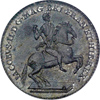 |
(1688) James II Plantation Token tin farthing. PCGS graded MS-62. These were struck for circulation in the New England and New York areas, which at the time of issue (around 1688), were plantation colonies of England. They were coined at the Tower Mint in London, using at least six obverse dies and seven reverse dies. Coinage weights were uncertain, but evidently these were struck at 50 to the pound, and worth the stated value of 1/24 of a Spanish Real. Later they were changed into "Proclamation Money" where they were worth 1½ Farthings, and often circulated at double face value in the Colonies. All examples are rare, and most show the familiar "tin pesting" as seen here, despite being of mint state quality. PCGS has graded only 6 coins this high, and none higher, making this as nice as these are ever found. An important, and rare colonial issue for the specialist.
The Plantation Token came about because of the tin price collapse in England during the period of 1679-80 (Breen). Although tin had been discovered and used since antiquity, being useful in making bronze, the idea of using tin for coinage had not been employed. This is because of the fact that tin turns into dust when exposed to extreme cold almost instantly, more slowly at normal temperatures, with evidence of tin pesting a by product of time and exposure to the elements. Nevertheless, the tin mine owners of Cornwall and Devonshire had a crisis, their tin mines were virtually worthless, and something had to be done with all that tin. What better solution than convincing the royal authorities under James II to coin the tin into money? Now the tin miners would have a steady source to sell their tin production to at higher prices than ever. Thus the Tower Mint began producing tin farthings and half pence for British domestic circulation from 1684-92. King James II's secretary Henry Guy then hatched the idea of making tin coins for the American Plantations, as the Colonies were known at that time, unless the Tower Mint had any objections. Apparently no objections were voiced, and soon the Tower Mint was coining these 1/24th Real coins for export. Literally within a few weeks of these being struck., James II was ousted during the "Glorious Revolution" which interrupted coinage. Analysis shows these coins to be 97.5% pure tin, which accounts for the always rough surfaces seen today. A London coin dealer named Matthew Young obtained two pairs of dies from these and restruck several in tin around 1828, these restrikes display a die crack in the right obverse field, and are nearly as rare as the originals, and also suffer from the same tin pesting as seen here. This particular coin is an original example, and shows no trace of the obverse die break.
Estimated Value $2,500 - 3,500.
From the Paul Arthur Norris Collection.
View details and enlarged photos
| Realized
$2,990 |
Lot 21 |
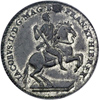 |
(1688) Holt's American Plantations tin farthing. Sidewise 4 in 24. PCGS graded MS-62. As nice as this issue is ever found, the surfaces show only the slightest tin pesting which appears as roughness. The original tin planchet shows bright white areas in the protected areas of the devices and lettering, with the open fields and upper devices a light gray color. Sharply struck and well preserved for the issue. PCGS in their online Population Report show only 6 graded this high, and none graded higher! An important colonial issue.
Estimated Value $2,500 - 3,500.
View details and enlarged photos
| Realized
$1,668 |
Lot 22 |
 |
(1688) Holt's American Plantations tin farthing. 1828 restrike. PCGS graded EF-45. Struck slightly off center and a bit unevenly but a pleasing silvery gray in color. A few minor surface marks in the left obverse field, scarcely visible with a glass. The obverse die has a crack to the right of the horse through the peripheral lettering. Scarce and in demand, especially so with such a nice planchet and none of the usual tin pesting that often pesters these.
Estimated Value $500 - 600.
View details and enlarged photos
| Unsold |
Lot 23 |
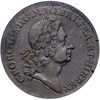 |
1723 Rosa Americana Twopence. PCGS graded EF-40. Toned a medium to dark brown, but the surfaces are finely rough throughout. We also note some minor planchet flaws, two on the right obverse edge, which are also present on the reverse. Well struck, and evenly worn.
Estimated Value $700 - 850.
View details and enlarged photos
| Unsold |
Lot 24 |
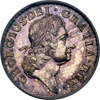 |
1723 Hibernia Farthing. Silver pattern. PCGS graded MS-65. Brilliant, prooflike surfaces with brighter silver devices offset by darker gold toning atop the mirror fields. A few flecks of blue near some of the lettering and devices are noted. Medallic in strike, with no signs of weakness even on the highest devices, each of which retains minute details. Examination will locate trivial handling ticks, but not enough to keep this from the gem class, and this may be the finest known example of this important pattern issue. It is the finest graded by PCGS, and alone as the only MS-65 graded. As to the variety, note the usual small die crack from the tip of the bust into the rim below, and DE are well clear of the head, while I touches. Nearly identical to the Norweb coin (Bowers & Merena, 11/15/88:3447) but this apparently a different coin as the toning and surfaces don't match up to the photo of the Norweb. A small hoard of these turned up in England in 1971, but many great collections still lack an example. While PCGS considers the silver coins of this issue to be mint state, they have traditionally been called "proof" for the past several generations. Regardless of the terminology, this is a beautiful coin worthy of the finest collection in the land.
There is an intriguing story behind the Hibernia coinage. King George I signed a Royal Patent on June 16, 1722, authorizing William Wood to coin copper halfpence and farthings for Ireland (this is the same William Wood who also received a patent for coinage of Rosa Americana coinage a few weeks later). However, the King's mistress, Ehrengarde Melusina, Dutchess of Munster and Kendal and commonly referred to as "The Maypole" stole this document (and the patent for the Rosa Americana coinage) as soon as the King signed and sealed it, then the Maypole ransomed each document to Wood for £10,000 (equal to over $500,000 today).
Wood paid the ransom to the King's Whore, then struck coins in earnest. Upon the coins unexpected arrival in Ireland, both houses of the Irish Parliament took the lightweight halfpence and farthing as insults. The old standard of 46 halfpence to the pound had been changed to 60 to the pound under Wood's Royal Patent. Thus, the Irish Parliament petitioned the Crown to revoke the authorization, not only because of the lightweight coins, but also because of the shenanigan of the Maypole in the affair. Wood himself added fuel to the blazing fire by letting his thoughts be known in the October 8, 1723 issue of the Flying Post. Thereafter, no Irish person would accept the coins, and they did not circulate. All this excitement caught the eye of Jonathan Swift (author of Gulliver's Travels and other books) who began a systematic smear campaign against Wood (Breen). Wood continued the fight, saying he would "cram his brass down their throats", to which followed accusations of bribery, debasement and fraud against the people of Ireland.
The battle to force his coinage on the people of Ireland was lost, and Wood resigned his patent in 1725. The invisible hand of commerce then acted, and speculators bought up the coins for close to bullion value, and shipped them to the American Colonies where copper coinage was greatly needed, and they circulated here for generations to come.
Estimated Value $10,000-UP.
From the Paul Arthur Norris Collection.
View details and enlarged photos
| Realized
$8,338 |
Lot 25 |
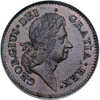 |
1723 Wood's Hibernia Halfpenny. PCGS graded MS-65 Brown. Satiny brown luster and fairly well struck on all but the uppermost devices, this gem boasts traces of red near the lettering and devices as well. Close examination will note a few minor flecks of red and brown but these are microscopic in nature and not at all distracting. Tied for the finest graded by PCGS in the brown category, they report a total of 5 this high, with 4 more in the red and brown category as MS-65, and a single coin higher. An outstanding example for the specialist.
Estimated Value $2,500 - 3,000.
View details and enlarged photos
| Unsold |
Lot 26 |
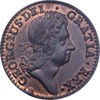 |
1723 Hibernia Halfpenny. PCGS graded MS-65 Red and Brown. A truly exceptional example of this issue, the surfaces boast substantial mint red surrounded by areas that have faded to light brown. Boldly struck on a clean planchet, and pleasing in every way. We note a trace of die rust near Liberty's leg on the reverse, and a minor die break on the lower obverse rim. Breen notes 23 minor varieties, indicating that these were struck in large quantities. Few were saved in high grades, and we note that PCGS reports only 3 graded this high, with a single coin graded higher of this variety.
Originally intended for circulation in Ireland, the shifting political winds and subsequent scandals kept the Wood's Hibernia coinage from circulating there, in time these ended up in casks destined for the Colonies in America, where good copper coin was always in demand, regardless of the political messages or scandals associated with a particular issue.
Estimated Value $2,000 - 3,000.
From the Paul Arthur Norris Collection.
View details and enlarged photos
| Realized
$1,783 |
Lot 27 |
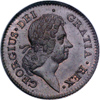 |
1723 Wood's Hibernia Halfpenny. PCGS graded MS-65 Brown Eliasberg. This is from the famous Louis Eliasberg sale. Traces of mint red in the protected areas and glossy. The devices are very boldly struck, and the curls especially so. One minor spot between the 23 of the date. PCGS has graded 5 this high in the brown category, with none graded higher. In an old green insert PCGS holder.
Estimated Value $1,500-UP.
Ex: Bowers and Merena's Eliasberg Sale, May 1996, lot 38.
View details and enlarged photos
| Realized
$1,208 |
Lot 28 |
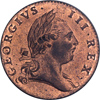 |
1773 Virginia Halfpenny, period after "GEORGIVS". PCGS graded MS-64 Red. A delightful example that boasts full original mint red! Splendid surfaces throughout, with an excellent strike and a very clean planchet. Both sides have just a couple of very trivial specks, but they are microscopic and not at all distracting. PCGS has graded 18 this high, with just one coin graded a notch higher in Red. Almost certainly from a keg that was found in Richmond, Virginia just prior to the Civil War. The hoard ended up in the hands of Col. Mendes I. Cohen of Baltimore, and eventually the keg was sold piecemeal until Wayte Raymond purchased the remaining 2,200 or so pieces in 1929. The hoard was uncirculated, and most were mint red but spotted or stained. An exciting coin to view and no doubt own, as rich in history as it is in color.
The Virginia colony had the only royal authorization for coinage (since 1609). However, no one ever bothered making coins, and tobacco was the standard medium of exchange along with various local and non local coinage imports. Finally, on May 20, 1773 the Virginia Assembly passed legislation authorizing the Tower Mint in London to coin halfpence pursuant to the royal authorization. Soon five tons of halfpennys arrived in Richmond, where the local Treasurer, Robert C. Nicholas, in classic bureaucratic fashion, decided not to release them pending the receipt of a Royal Proclamation authorizing him to do so (Breen). A year later, when the desired Royal Proclamation did arrive the Revolution was about to erupt. Coins of all types were hoarded, fearing the worst. As the war dragged on, many Virginia halfpennys were spent, and they have turned up in various archeological sites in circulated grades.
Estimated Value $2,000 - 2,500.
From the Paul Arthur Norris Collection.
View details and enlarged photos
| Realized
$1,265 |
Lot 29 |
 |
(1680) London Elephant Token Halfpenny. Thick planchet. PCGS graded MS-64 Red and Brown. An outstanding example of this rare issue, one which boasts lovely mint red in the protected fields, and light tan toning elsewhere. The surfaces are very clean, as expected on a near gem coin, and examination will not find fault. One tiny speck is noted on the back foot of the elephant, and this will help identify this specimen in the future. Fully struck throughout, with bold details on the elephant and lettering. Peck believed these were struck around 1672, while the Guide Book guesses the year was 1694, while others say 1680. The motto GOD PRESERVE LONDON probably refers to the outbreak of the Black Death Plague and Great London Fire of 1665-6. The exact circumstances of the Elephant halfpence is not known, but a few did turn up in non collector accumulations in New Jersey and New York, where all coins were greatly needed for commerce. PCGS has graded only 1 coin as such, with 2 others graded higher of this particular variety.
Estimated Value $3,000 - 4,000.
From the Paul Arthur Norris Collection.
View details and enlarged photos
| Realized
$6,038 |
Lot 30 |
 |
1694 Carolina Elephant Token. O over E. PCGS graded VF-20. Medium chocolate brown in color with very pleasing surfaces that show smooth, even wear on the obverse. On the reverse, the central lettering is very weak with portions illegible, but the all important O/ERS and the date visible with a glass. One tiny mark located above the(OR)S will help to identify this specimen and another similar mark is located near the rim to the right of GOD. Long called a low rarity-6, and while not on par with some of the finer examples known (Norweb, Picker, Garrett) certainly a worthy coin in its own right. PCGS has only graded 4 examples of this variety, all between the grades of VG-VF.
Estimated Value $6,000 - 7,500.
From the Paul Arthur Norris Collection.
View details and enlarged photos
| Realized
$4,255 |
Lot 31 |
 |
1694 New England Elephant Token. SEGS graded MS-63 "Robinson Copy". This is a copy produced around 1861 by Robinson of the famous "elephant token" of 1694. Breen notes that he believes only 15 were struck in brass. This particular token weighs 138.3 g according to the SEGS insert. We note the surfaces are quite clean, with pleasing color throughout. On the reverse there is a minor red spot on the W of NEW, which will assist in identifying this specimen in the future. Rare and seldom offered.
Estimated Value $100 - 150.
From the Paul Arthur Norris Collection.
View details and enlarged photos
| Realized
$345 |
Lot 32 |
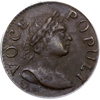 |
1760 Hibernia-Voce Populi Farthing. Large letters. PCGS graded AU-58. A rare coin indeed, and especially as the finest graded by PCGS! It is alone in the AU-58 grade, and none have yet been graded as Mint State. Sharp on the central obverse and around the periphery, the only sign of weakness is located at the central reverse. Medium brown in color and smooth save for an ancient slightly rough area located on the lower obverse. If you demand the finest for your colonial collection, then you'll have a field day in this sale, with this particular coin circled in your catalog. An exceptional example of this rare issue.
Estimated Value $4,500 - 5,500.
View details and enlarged photos
| Realized
$3,450 |
Lot 33 |
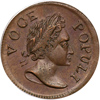 |
1760 Hibernia-Voce Populi Halfpenny. "VOOE POPULI". PCGS graded MS-64 Brown. Perhaps the very finest known of the issue, this coin boasts not only a bold strike but also very pleasing color and surfaces. Better than the Garrett or Norweb examples, as well as the Roper EF (lot 159) which wasn't photographed in that sale. PCGS has graded one as high as MS-62, and above only this specimen as a near gem MS-64. The dies show minor roughness at the centers, particularly on the reverse. Struck on a very nice planchet, and well enough preserved to retain a trace of mint red near the lettering and devices. A simply magnificent example of this popular variety and one of the highlights of this specialized collection.
The VOOE error appears to be an engraving mistake, the "C" was first engraved upside down perhaps rather than a "die break" as noted in most prior offerings of this variety. If one studies the width and proportion of the additional area which closes the "C", it appears to be that type of error rather than any sort of die break.
These were thought to have been coined in Ireland, and intended for circulation there, but ended up circulating along the eastern shores of America after speculators bought them up and shipped them to these shores.
Estimated Value $4,000 - 5,000.
From the Paul Arthur Norris Collection.
View details and enlarged photos
| Realized
$4,140 |
Lot 34 |
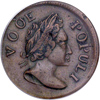 |
1760 Voce Populi Halfpenny. "VOOE POPULI". PCGS graded AU-53. A particularly lovely example of this colonial issue, the planchet is clean and fresh, and toned a pleasing light tan color. The legends and devices have minor verdigris from brief circulation, and this gives the coin an enhanced definition and medallic appearance. Excellent surfaces that show only trivial signs of handling or circulation, and we feel that most collectors will love this coin for its color and surfaces. The engraving error of VOOE instead of VOCE is quite clear, and quickly identifies this particular variety. It appears the C was engraved backwards, or engraved over an errant "O", as the serif of the C is plain in the location where it belongs. PCGS has only graded 3 above this one, two of which are in mint state. A rare and desirable issue this nice.
Estimated Value $1,000 - 1,200.
View details and enlarged photos
| Unsold |
Lot 35 |
 |
1766 Pitt Token Halfpenny. PCGS graded MS-64 Brown. Glowing brown luster throughout, with no troubling spots or similar signs of age. The strike is typical on the obverse, with most of Pitt's curls bold, the reverse has minor weakness on the ships portholes, but most are present. A hint of streaky brown color on the obverse, while the reverse boasts an even and lovely brown color. We do note however, three faint scratches in the right obverse field, and another through the word STAMPS on the obverse. Certainly one of the finest of these important historical tokens, PCGS has graded only 2 this high, with a single coin graded higher. Most are found in much lower circulated grades, and just have few have been located in mint state. Nicer than examples in the Roper, Picker, Robison and Norweb collections, and as nice as the Garrett example. Struck slightly off center on the reverse, with the tops of the letters FRIENDS missing, as usually seen.
The Pitt token commemorates one of the most historic events that soon led to the American Revolution. King George III's Chancellor of the Exchequer, George Grenville, introduced the Stamp Act in Parliament in early 1765, where it passed without debate, in order to help pay for French and Indian Wars. Parliament was simply extending the British system of stamp duties to the American colonies. Neither Grenville nor his advisors had any idea that the Stamp Act would generate any opposition from the colonies in American (Breen).
Nevertheless, the Stamp Act included several provisions which the colonists saw as a threat. For instance, the Act required the purchase of tax stamps for every sheet of paper or parchment, hence every newspaper, broadside, almanac or like publication had to pay the tax or would be considered contraband. This implied the royal authorities were trying to tax local publications out of business, an attack on the freedom of the press!
As soon as copies of the Stamp Act arrived in New York by August of 1765, colonial assemblies started protesting. In Massachusetts, the radical Sons Of Liberty formed in secret to organize resistance, likewise in New York where the locals formed the Friends of Liberty and Trade club. Soon a Stamp Act Congress was called, and they met on October 7, 1765, with representatives from all 13 colonies, to coordinate action. Its major resolution declared that the Stamp Act and the related measures extended "the jurisdiction of the Courts of Admiralty beyond its ancient limits" and that Parliament had "a manifest tendency to subvert the Rights and Liberties of Colonists." The congress further resolved that "it is inseparably essential to the Freedom of a People, and the undoubted rights of Englishmen, that no taxes be imposed on them but with their own consent, given personally or by their representatives," and that the colonists "are not, and from their local circumstances cannot be, represented in the House of Commons." (Breen).
Soon the opposition to the Stamp Act was so great that the costs of enforcing it exceeded the meager income gained. Loyalists who used the hated stamps were boycotted, or even worse, some witnessed their houses burned to the ground. Many in Parliament were outraged, with such treasonous behavior rampant in the colonies, until Sir William Pitt, the most popular statesman in England and known as the "Great Commoner," defended the rebellious colonists and their opposition to the Stamp Act. Pitt spoke to Parliament in January of 1766 and stated "as subjects they are entitled to the common right of representation, and cannot be bound to pay taxes without their consent," and even demanded the repeal of the hated Act, which followed on March 18, 1766. So disgusted was King George III, that he dismissed his Chancellor of the Exchequer Grenville over the debacle.
Naturally, the colonists hailed Pitt as their Defender of Liberty, and various coins and medals were struck in his honor. The local New York group known as the Friends of Liberty and Trade had gunsmith James Smither engrave and issue this token, allegedly using sketches from Paul Revere, and they are thought to have been struck in either New York or Philadelphia.
One of the highlights of the Norris collection, and certain to be highly prized for generations to come.
Estimated Value $10,000-UP.
From the Paul Arthur Norris Collection.
View details and enlarged photos
| Realized
$6,900 |
Lot 36 |
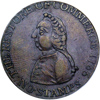 |
1766 Pitt Halfpenny Token. PCGS graded AU-50. We have a delightful selection of Pitt tokens in this sale in various grades. These are truly rare items and collectors would do well to secure one of these for their collections from this sale. The strike on this example is sharp, and we note only a single porthole is weak on the ship, with all rigging and other details clear. Perfect medium brown in color and with very nice surfaces throughout, and no spots or signs of corrosion to be found anywhere.
Estimated Value $2,750 - 3,250.
View details and enlarged photos
| Unsold |
Lot 37 |
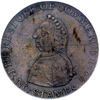 |
1766 Pitt Halfpenny Token. PCGS graded EF-40. Sharply struck and well centered for this issue, with all of the lettering present although the rims are low in some areas. A pleasing light brown in color and problem free. While not as nice as the mint state example offered in this sale, this is certainly a high grade coin that few collectors could best.
Estimated Value $1,600 - 1,800.
View details and enlarged photos
| Unsold |
Lot 38 |
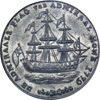 |
(c. 1779) Rhode Island Ship Medal, with wreath. PCGS graded MS-64. One of the very finest known specimens of this rare issue, with two seen this high at PCGS, and none higher out of a total of 7 graded by that service. The surfaces are simply amazing for this issue, often these are found with corrosion (see below), not so here, the surfaces are mint fresh and well preserved. As to the strike, we note full details on even the tiny flags atop the ships masts, and just trace weakness on the central ship portholes perhaps caused by die failure as this is a late obverse die state. The reverse is boldly struck, and the color is a steel lustrous gray throughout. We do note a minor die crack through the upper right above the ship, and a die lump on the rigging of the foremast. Much better than the specimen offered in Roper, Robison, Garrett, Norweb and others, and long known to be represented by just a few known struck in pewter. Of those listed in the census below, most seem to be of this die pairing.
One side of the token depicts Conanicut Island, with rows of American and French soldiers marching with weapons towards small boats offshore to the right, while Howe's 3 menacing triple masted ships lie just offshore, with the legend loosely translated "Americans fleeing Rhode Island August 1778" while the obverse (ship side) shows a proud 3 masted ship (Howe's) with its sails furled but flags flying proudly and the legend surrounding something like "Admiral Howe's flagship, 1779, " but importantly the word "vlugtende" (fleeing) has been removed below the ship on the die (the die was reannealed and a wreath was placed below the ship). Breen does not note if these coins have been punch matched to any other known coiners, and the engraver, mint and designer remain to be discovered.
Why these satirical coins were struck remains a mystery, Breen deciphered the legends in the historical context to refer to Conanicut Island in Narragansett Bay west of Newport. Loosely translated, the legends state "The American's had to run away in 1778, now there goes Adm. Howe the same way in 1779". Admiral Richard Howe and Henry Clinton of Great Britain were in Colonial America to stop the rebelling American's, and these two leaders nearly had it out with Colonial and French troops off Conanicut Island. However, a storm came up as the two navy's jockeyed for position, and both sides retreated, leaving the battle for later. Howe retook Conanicut Island in August of 1778. Fifteen months later, the battles had turned, and Howe retreated from Conanicut island in a hurry leaving it for the American and French forces. On a few examples the word "vlugtende" is below the ship, which means "fleeing" (referring to Howe), and apparently the coiners feared reprisals for memorializing his retreat in such an insulting manner, so the dies were changed to remove the offending word, and a politically acceptable wreath was put in its place.
Estimated Value $7,000 - 10,000.
Here is a census of those we could reasonably locate: 1). The specimen offered here from the Paul Arthur Norris Collection PCGS graded MS-64, previously from our Benson Collection Sale, 2/2001:34. Apparently tied for the Finest Known (Norris upgraded to this coin from specimen #3 below) 2). Another, not seen PCGS MS-64. 3). The Paul Arthur Norris specimen, PCGS MS-62 (plate) our Benson sale 2/2001:35. Rim clip at 4:00 o'clock on the obverse. 4). Another, not seen, PCGS graded MS-60. (probably one of those listed below). 5). Kagin's 332 sale, 2/83:1006 (plate)," AU-Uncirculated, small spot in upper right obverse field". 6). Kagin's 313 GENA Sale, 9/78:1770 (plate) "About Uncirculated-55". 7). The Parsons/Ellsworth/Garrett specimen, Bowers & Ruddy 10/80:1328 (plate) "EF or better" at $5,000. Identifiable by a small scratch above stern flag. 8). Paramount's Burnheimer Sale, 5/76:502 (plate) "AU-50 Several areas of roughness near the rims as is usually encountered on pewter pieces" at $2,050. 9). The Norweb specimen, Bowers and Merena Galleries, 10/87:1262 (plate) "EF-40, spots of corrosion" at $1,000. 10). NERCG's Commonwealth Sale, 7/77:34 (plate), "VF-35 choice surfaces and color" at $1,000. 11). The Roper specimen, Stack's 12/83:174 (plate), "VF, 3 or 4 spots of tin pest obverse". 12). New Netherlands 48th sale, 11/56:792 (no plate) "VF somewhat defective mainly about the periphery, recently obtained abroad" and almost certainly the same specimen as New Nethlands 51st sale, 6/58:183 (no plate) "VF slightly imperfect as always; edge scaly and irregular, obtained in England". 13). Robison specimen, Stack's 2/82:71 (plate). "VF holed".
View details and enlarged photos
| Realized
$18,975 |
Lot 39 |
 |
1783 Chalmers Shilling. Birds, short worm. PCGS graded EF-40 "Short Worm". A rare silver colonial issue, this one from the state of Maryland. No official authorization exists for the coinage, but similarly no law prevented Capt. John Chalmers from making these coins of honest weight and fineness. The surfaces of this coin are particularly pleasing, toned with darker gray in the fields, and lighter silvery gray devices. Excellent surfaces and strike, the coin is well centered and preserved in every way. There are no identifying marks or characteristics worth describing. PCGS has graded a scant 5 this high, 5 graded higher (best AU-55) of this variety.
Breen and others suggest that the worm being fought over by the two birds is really a snake. Note that the so called worm has a head which is much larger than the body, as seen in the snake above and outside the fence above the birds. Further, a worm would be proportionately much smaller than depicted here. He also interprets the scene portrayed on the obverse as "While you states go on squabbling over trivialities [boundary disputes?], you don't notice what is coming over to devour you", referring to the larger snake above. He goes on to say that this is a warning that a strong centralized government (the large snake) might well destroy the hard-won status of individual states as independent sovereign entities under the Confederation.
Given the fineness and value of the coins produced, it is unlikely that Chalmers made any money with his venture. Perhaps Chalmers hoped to win a coinage contract with the state of Maryland, and these much needed silver coins are all that remains of his proposal. Perhaps these were more for advertising the family business rather than a coinage for profit motive. Most are found in well worn condition, and they were struck in three denominations, shilling, sixpence and threepence, all of which are fairly to extremely rare.
Estimated Value $5,000 - 6,000.
From the Paul Arthur Norris Collection.
View details and enlarged photos
| Realized
$5,060 |
Lot 40 |
 |
1670 French Colonies 5 Sols. PCGS graded AU-50. Steel gray in color with traces of luster in the fields beneath. A decent strike, which is sharp around the periphery and displays a touch of weakness at the centers. We note faint horizontal lines on both sides which may have been from the planchet preparation process or perhaps adjustment marks, but they are scarcely visible regardless. Identifiable by a tiny edge flaw just above the Sun and to the right, which is also present on the reverse, but small enough to be hard to see in the PCGS holder. An important early French issue struck for Canada or the Louisiana Territory. Scarce this nice, and comparable to the Roper specimen (Stack's 12/83:182) in grade and quality.
Estimated Value $3,000 - 4,000.
From the Paul Arthur Norris Collection.
View details and enlarged photos
| Realized
$2,300 |
Lot 41 |
 |
1670 French Colonies 15 Sols. PCGS graded AU-55. A rare example of this coinage authorized by Louis XV in 1716 for copper coins, which failed as the copper appeared to brassy. Later, in 1720 silver coins were tried as seen here, and these were struck in very limited quantites. The edges show light adjustment marks and the surfaces are slightly rough. We note light gray tones with hints of iridescence in the fields. Boldly struck throughout. This is the only example of this date graded by PCGS.
Estimated Value $2,000 - 2,500.
From the Paul Arthur Norris Collection.
View details and enlarged photos
| Realized
$1,208 |
Lot 42 |
 |
1709-AA French Colonies 30 Deniers. PCGS graded VF-30. An extremely rare issue that Vlack states is represented by just 2 or 3 specimens. Breen estimated the population at 7 or 8 known when he published his mammoth Encyclopedia in 1988. Originally struck to pay the French soldiers in the Ardennes, and many were spent in Alsace, where they eventually ended up in Canada or the Louisiana Territory. Struck at the Metz Mint in France, and this is the first year of issue of this new design. We note minor surface roughness and a few small raised areas as this billion (mostly copper, 20 percent silver) issue was exposed to a damp climate at some point. Boldly struck with all the devices sharp and most of the lettering quite clear as well. A coin for the specialist who really demands something rare in impossible to duplicate.
Estimated Value $2,000-UP.
From the Paul Arthur Norris Collection.
View details and enlarged photos
| Realized
$1,179 |
Lot 43 |
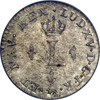 |
1740 French Colonies Half Sou Marque. PCGS graded MS-62. A rare issue in any grade, this particular example is the only one graded by PCGS according to their online Population Report, giving an indication how few of this date are found. The surfaces are slightly rough probably as made, and the coin has light silvery gray color with hints of dark colors intermixed. Fully struck by the dies, and with no other problems worthy of note.
These were issued for the French colonies in Canada, and many circulated into the Louisiana Territory as trade was flourishing at the time. Breen notes these to be "rare", and given that this is the only example of this date graded by PCGS, they may be quite rare.
Estimated Value $2,000 - 2,500.
From the Paul Arthur Norris Collection.
View details and enlarged photos
| Realized
$1,208 |
Lot 44 |
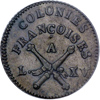 |
1767 French Colonies Sou. PCGS graded AU-58. Although quite a few were minted, Breen notes that over 98% were counterstamped with the RF, this is one of the few that was not counterstamped! Light brown in color and boldly struck, the only tiny flaw is a small dark toned area on the C of COLONIES and a couple of ancient lines on the lower right obverse. An extremely rare coin and worthy of a top notch collection. PCGS has only graded one example higher than this.
Estimated Value $1,200 - 1,400.
View details and enlarged photos
| Realized
$1,495 |
Lot 45 |
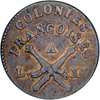 |
1767 French Colonies Sou. PCGS graded EF-40. Light coppery red in color and boldly struck. These were issued for the French Colonies in America where they circulated widely amongst the trappers and traders of the Louisiana Territory.
Estimated Value $450 - 550.
View details and enlarged photos
| Realized
$311 |
Lot 46 |
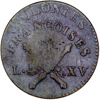 |
1767 French Colonies Sou, counterstamped RF. PCGS graded AU-50. One of the more common coins from the French Colonies in America, this one is toned a pleasing medium brown and has nice surfaces.
Estimated Value $350 - 450.
View details and enlarged photos
| Unsold |
Lot 47 |
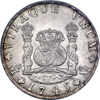 |
1776 Continental Currency - Pewter, inscribed "curency". PCGS graded MS-63. Frosty luster in the fields and mostly silvery white, save for an alluring touch of peripheral gold color. Fully struck by the dies, with strong definition on all the devices and lettering.
Estimated Value $1,000 - 1,500.
From the Paul Arthur Norris Collection.
View details and enlarged photos
| Realized
$1,840 |
Lot 48 |
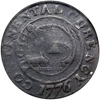 |
1776 Continental Currency. "CURENCY". PCGS graded VG-10. Dark and evenly toned, this well circulated example represents an affordable opportunity to purchase one of America's first prototype dollar sized coins. Although the denomination has been subject to question, it is believed that these were intended to be struck in silver, but the silver was not available (shipping problems from France) and hence most were struck in tin (called pewter incorrectly, although the two alloys are quite similar). The obverse devices are mostly clear, but we not weakness on the left side of the obverse, and the reverse is complete as well, but some of the links are weak. Not quite a gem, but priced accordingly.
Estimated Value $3,000 - 4,000.
View details and enlarged photos
| Realized
$4,715 |
Lot 49 |
|
Withdrawn
| Unsold |
Lot 50 |
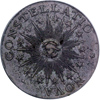 |
1783 Nova Constellatio. Pointed rays, small U.S. PCGS graded AU-55. Boldly struck and well centered, this is certainly a high grade example of this scarce coin which shows full details on the central all seeing eye. The obverse shows scattered roughness in the fields, likely from before the coin was struck. On the reverse we note a pair of minor scratches in the central field. Medium brown and pleasing to the eye. PCGS has graded 11 as such, with 8 graded higher in AU-58, and 3 mint state coins at the top as high as MS-62 according to their current online Population Report.
Estimated Value $1,400 - 1,600.
View details and enlarged photos
| Unsold |
|
|